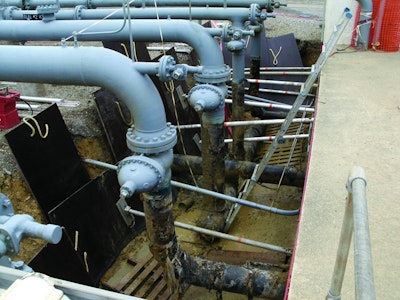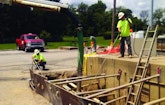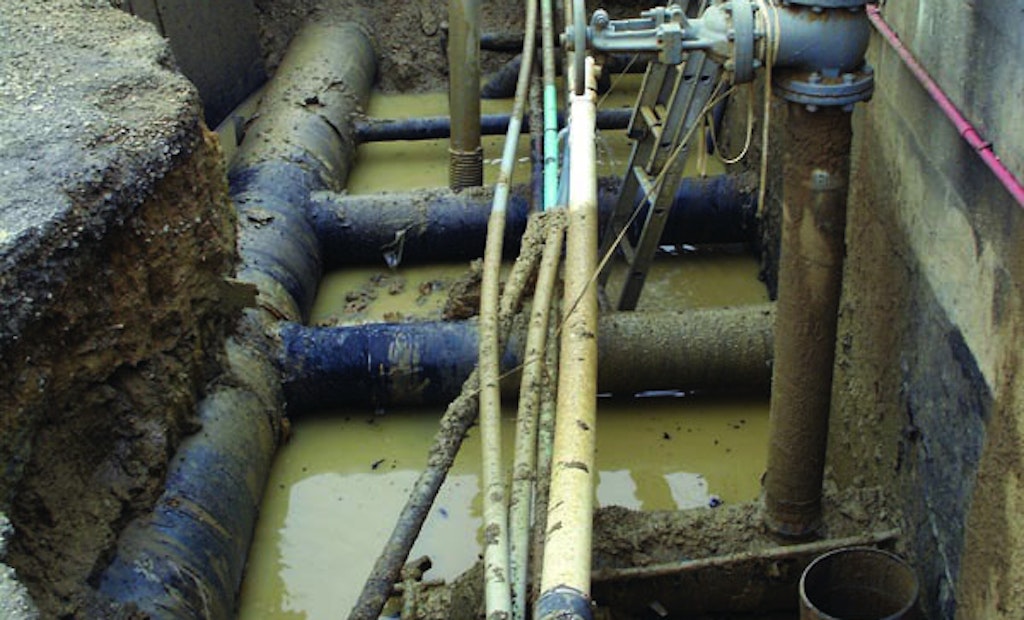Interested in Cleaning?
Get Cleaning articles, news and videos right in your inbox! Sign up now.
Cleaning + Get AlertsAn annual survey of high-pressure gas transmission mains by a local utility near Cincinnati pinpointed anomalies on the premises of the natural gas plant. Its maintenance policy allowed only vacuum excavation to avoid damaging the vast number of underground pipes while exposing them for visual inspection.
The plant’s pipeline integrity contractor had trailer-mounted hydroexcavation units, but using them would take too long to remove the anticipated volume of material. Seeking a full-size machine, he hired Tele-Vac Environmental of Mason, Ohio.
“We’ve worked together before,” says hydroexcavation manager Alex DuDeVoire. “Our responsibilities were to dig two standard 5- by 10- by 8- or 9-foot-deep trenches, expose the anomalies and make the pits safe for entry. We figured one to two weeks max on the job.” Instead, undocumented pipes, soil flows, rain and a near cave-in stretched the project to almost four weeks.
Work zone
The anomalies appeared near the compressor station’s concrete substructure, which resembled a basement with a flat roof 2 feet above grade. Inflow and outflow pipes ran above and through the substructure. Work began on the outflow side, which had the most anomalies.
Shamus Ridner and Chris Distler parked the 2013 HXX hydroexcavator (Vactor Manufacturing) 20 feet away. Distler operated the truck, which has a 12-cubic-yard debris body, 5,250 cfm/28-inch Hg Hibon 8702 TriLobe blower, and a 1,300-gallon/20 gpm water system.
The men used Monro jet rotating nozzles (NozzTeq) and 10 gpm at 2,500 psi to open the trench. Their first challenge was not to damage the coating on the above-ground piping as they worked from the substructure back. Soils were compacted hard clay and rock for 3 to 4 feet, then sand and pea gravel backfill.
“The loose material kept falling out, threatening to undermine the sidewalls of the ditch,” says DuDeVoire. “If the heavy material collapsed on the transmission mains, it would damage the coating.”
The farther back the men dug to uncover a pipe, the more undocumented lines they found with potential coating issues. “The GC said to expose all of them,” says DuDeVoire.
While you’re here ...
The jungle gym of pipes made it difficult for the pair to enter the trench, to work without damaging coatings and to clean 1 to 2 feet below lines to facilitate inspection and repairs. The congestion also made it impossible to insert shoring boxes. Ridner and Distler used shoring boards instead, but even they had to be pulled up to enlarge the hole as more problem pipes emerged. The trench eventually reached 50 feet long and 12 feet wide.
Soil flows prevented shoring one end of the pit, so they sloped it back, tapering the width to 10 feet. “It’s very difficult to excavate OSHA-compliant slopes and benching with pressurized water,” DuDeVoire says. “Shamus and Chris deserve a lot of credit for making everything as safe as possible for the people who will spend days working in those trenches.”
Just as the outflow trench work was almost done, the client requested exposing the piping coming out of the ground on that side. “It became a never-ending project where we started one thing and they kept adding to it,” DuDeVoire says. “However, as long as we’re there, we’ll do anything customers require to keep them happy and complete the job.”
Ridner and Distler excavated 12 inches around the pipes and down 3 feet to the concrete footers supporting them. Before leaving the trench, they laid pallets where possible or poured in pea gravel to form a floor for the inspection and coating contractors.
More wrinkles
Excavation at the inflow trench duplicated work at the first pit until the men exposed a broken 4-inch PVC pipe. It drained stormwater from part of the property and the discharge from a sump pump in the compressor station.
“The amount of water draining from the pipe impeded progress,” says DuDeVoire. “Then major storms struck over two weekends. On the following Mondays, Shamus and Chris found 2 or 3 feet of water in the trench and a lot of muck under the pipes.”
They spent half the morning sucking up several thousand gallons of water and repeating the cleaning work accomplished the previous Friday. Distler dumped the material on site. Finally, a contractor spliced in a new length of pipe after Ridner cleaned the exterior of the broken line.
As excavation neared a service road, soil flow began to undermine it. The men switched their attention to other extemporaneous projects while waiting for a contractor to cut out that section of road to prevent it from collapsing onto high-pressure gas mains.
The inflow trench reached 45 feet long and tapered from 12 to 10 feet wide at the slope back. Twice daily, Distler emptied the truck on site, eventually off-loading 360 cubic yards. After the material dried somewhat, the general contractor removed it. To date, contractors have inspected and repaired all anomalies at the gas plant.









